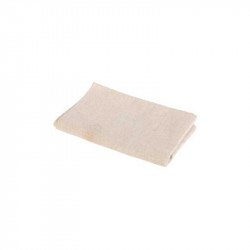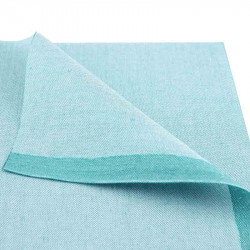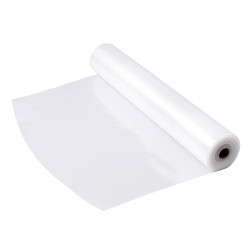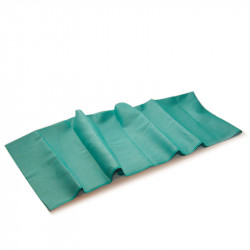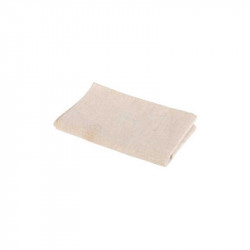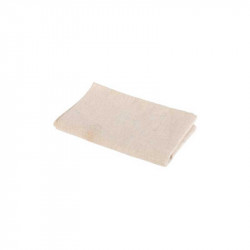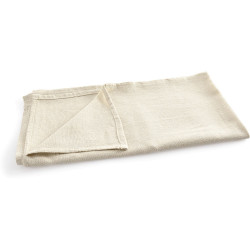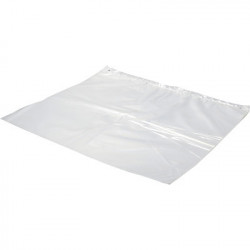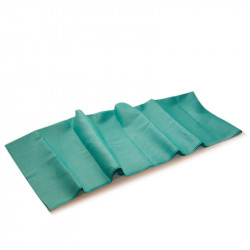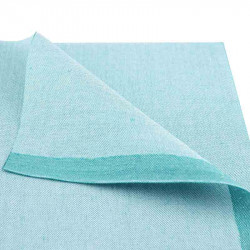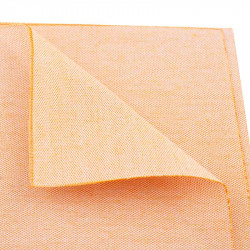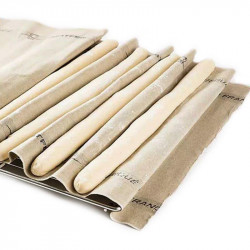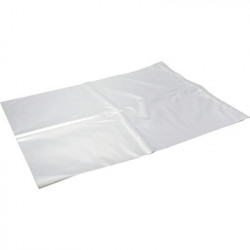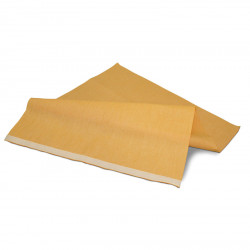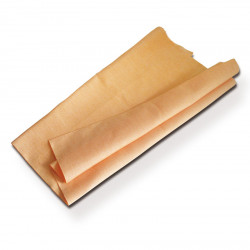Dough cloths
What is a dough cloth?
A dough cloth, also known as a baking cloth or linen cloth, is a cloth used to cover, store or let dough rise. It is often made of cotton or linen and has a smooth, fine texture that allows the dough to stick to it. The dough cloth prevents the dough from drying out and protects it from dust and dirt. It can also be helpful when shaping bread or making other pastries, as it supports the dough and allows it to hold its shape.
What is a dough cloth or dough cloths good for?
A dough cloth is used when baking bread or other pasta. It is used to cover the dough and protect it from drying out while it rises or rests. The dough cloth also keeps the dough warm and protects it from drafts.
What are the differences of linen, plastic or cotton dough cloths?
The differences between linen, plastic and cotton pastry cloths lie in their properties and uses.
1. Linen:
- Natural fabric made from flax fibers.
- Highly absorbent and breathable.
- Perfect for covering dough as it absorbs moisture while ensuring that the dough does not dry out.
- Holds its shape well and does not tend to warp.
- May leave small residues in the dough due to its coarser texture.
2. Plastic:
- Usually made of PVC or silicone.
- Water resistant and not breathable.
- Easy to clean and often dishwasher safe.
- Prevents dough from drying out, but may interfere with fermentation.
- May become misshapen or discolored with prolonged use.
3. Cotton:
- Natural fiber that is soft and absorbent.
- Breathable and helps dough ferment evenly.
- Easy to clean, but not always dishwasher safe.
- May wear out or shrink with extended use.
- Must be washed regularly to prevent odors or residue.
The choice of dough cloth depends on personal preference, desired use and individual requirements. Some prefer linen for bread dough, while others use plastic or cotton for cookie dough.
Which dough cloth is best for which bread?
Choosing the right dough cloth depends on several factors, such as the type of bread to be baked and the baker's personal preferences. Here are some general recommendations:
1. Linen cloth: Linen cloths are very popular for baking sourdough bread or other types of bread that need to rise for a long time. Linen cloth holds the moisture of the dough well and allows the dough to ripen well.
2. Cotton cloth: Cotton cloths are versatile and can be used for different types of bread. They are easy to clean and can also be used to cover buns or baguettes.
3. Floursack Cloth: Floursack cloths are very thin and light, yet strong and durable. They are good for types of bread that require a loose crumb, such as ciabatta.
4. Muslin Cloth: Muslin cloths are similar to Floursack cloths, but woven a little tighter. They work well for a variety of breads, such as durum wheat bread.
It is important to note that these are only recommendations and ultimately the baker's personal preferences are key. Someone may prefer certain cloths for certain breads, while other bakers may have different preferences.
Is it allowed to wash a dough cloth?
Yes, you can wash a dough cloth. It is important to wash the cloth thoroughly after each use to remove any possible germs or residue from the dough. When doing so, one should follow the manufacturer's washing instructions to ensure that the cloth is not damaged. In most cases, the dough cloth can be machine washed at a low temperature or washed by hand. Afterwards, the cloth should be allowed to dry well before using it again.
Can you do it without a pastry cloth?
Yes, it is possible to work without a dough cloth. Your roll can be rolled out on a well-floured work surface, for example. Instead of a dough cloth, you can also use a clean dish towel or parchment paper to cover the dough and let it rest. There are also dough rollers that have special surfaces to prevent the dough from sticking. Overall, though, a dough towel is a helpful addition because it covers the dough evenly and provides protection from drying out.
Is there a substitute for baker's linen or pastry cloth?
Yes, there are several alternatives to baker's linen or pastry cloths. Some options include:
1. A clean dish towel or cotton cloth: These can serve a similar function by keeping dough from drying out and absorbing moisture.
2. Silicone baking mats: These reusable mats are non-stick and can absorb dough without it sticking to them. They are easy to clean and can also be used to roll out dough.
3. Parchment Paper: Folded or rolled up, parchment paper can serve as a base for dough. It is non-stick and prevents the dough from sticking to the item.
4. Plastic wrap: Covering the dough with plastic wrap prevents it from drying out. It can also be used for resting the dough.
It is important that the alternative is clean, dusted with flour if necessary and made of suitable materials such as cotton, silicone or parchment to ensure good quality dough.
What can you do if the dough sticks to the dough cloth?
If the dough sticks to the dough cloth, you can take the following measures:
1. Add flour: Sprinkle some flour on the dough and the cloth to prevent the dough from sticking.
2. Coat the dough with oil: Lightly oil your hands and coat the dough with it. This will reduce stickiness.
3. Refrigerate: Place the dough in the refrigerator for a short time to make it a little firmer and reduce stickiness.
4. Use a dough card or dough spatula: Use a pastry card or spatula to gently loosen the dough from the cloth without sticking.
5. Moisture: Lightly moisten the dough cloth to smooth the surface and reduce sticking.
6. Alternate cloth: If the dough cloth is too sticky, you can replace it with a clean, dry dish towel or baking paper.
7.Larger cloth: use a larger cloth to give the dough more room to spread and prevent it from sticking.
8. Use silicone mats: silicone mats can ensure that the dough does not stick. These can be purchased and provide a non-slip surface on which to work the dough more easily.
With these tips, the dough should no longer stick to the dough cloth.
Why should you use baker's twine?
There are several reasons why you should use baker's linen:
1. Moisture control: baker's linen is a material that absorbs moisture well and releases it well at the same time. Baking bread or pastries often releases a lot of moisture, which is absorbed by baker's linen. As a result, the surface of the dough remains moist and does not dry out. This results in a stronger crust and a more beautiful appearance of the pastry.
2. Heat regulation: baker's linen also helps to regulate heat during baking. It insulates the dough and keeps it warm while it rises. This provides even and stable heat in the dough, resulting in consistent baking results.
3. Non-stick properties: Baker's linen has natural non-stick properties, which prevents the dough from sticking to the surface. This makes it easier to remove the dough from the linen surface without getting dough residue or impurities into the baked goods.
4. Sustainability: baker's linen is a sustainable alternative to disposable paper baking pans or aluminum foil. It is reusable and durable, so it can be used for a long time with proper care. This reduces waste from disposable baking pans and reduces the environmental footprint of baking.
5. Tradition and Authenticity: The use of baker's linen has a long tradition in the art of baking. Many professional bakers swear by the use of baker's linen to achieve a traditional and authentic baking result. So by using baker's linen, you can preserve the artisan heritage of baking.
What are the different baker's lines and what is important to know?
There are several types of baker's linen used in the production of bread and other baked goods. Here are some examples:
1. Linen cloth: This is the traditional material used for baker's linen. It is woven from linen fibers and has a coarse texture. Linen fabrics are very breathable and absorb excess moisture, which is important for getting a good crust on bread.
2. Cotton fabric: Cotton fabrics are also commonly used for baker's linen. They are softer than linen fabrics, but still breathable and absorb moisture well. Cotton fabrics are available in a variety of thicknesses and textures.
3. Proofing baskets: Proofing baskets are special baskets lined with baker's linen. They are used to shape and support bread dough during the proofing process. Proofing baskets come in a variety of shapes and sizes, and they add a beautiful pattern to the bread.
What's important to know:
1. Baker's linen should be washed before first use to remove dirt and starch from the fabric. This can usually be done in a washing machine at a low temperature or by hand washing.
2. Before the dough is placed on the baker's linen, it should be lightly dusted with flour to prevent the dough from sticking.
3. After use, baker's linen should be thoroughly cleaned and dried to prevent the formation of mold or unpleasant odors.
4. The more often baker's linen is used, the more flour residue will settle in the fabric. This can stiffen the fabric and affect breathability. Therefore, it is important to clean baker's lines thoroughly on a regular basis.
5. Baker's lines can also be used to cover dough or bread during the fermentation or resting process. They protect the dough from drying out and prevent the formation of a hard crust.
Overall, baker's lines are an important tool for bakers to improve the quality and aesthetics of bread and other baked goods.
How good are plastic pastry sheets?
Plastic pastry sheets are usually excellent because plastic is a smooth and easy to clean material. It allows for easy handling and makes rolling and shaping dough easier. Plastic pastry sheets are available in a variety of thicknesses, which makes them versatile. They are also often non-slip, which makes working with dough easier. However, they can tear or deform if the dough is kneaded or rolled out too much. Some chefs also prefer to use cotton or linen cloths, as they are considered more breathable and natural. Ultimately, however, it comes down to the personal preferences of the cook.
What does a dough cloth protect the dough from?
A dough cloth protects the dough from drying out and prevents a hard crust from forming. It also keeps the dough warm and protects it from drafts.
Should everyone who bakes bread at home have a dough cloth?
It is not mandatory to have a dough cloth to bake bread at home. There are several ways to cover the dough and let it mature. In particular, you can cover a bowl with a clean dish towel or use plastic wrap.
However, a dough towel can help keep the dough from drying out and provide a good moisture balance as it rises. It also allows good air circulation and helps build a good crust. A linen dough towel is especially recommended because it is breathable and can absorb excess moisture from the dough.
Overall, then, a dough towel can be a practical and useful accessory for achieving better baking results. However, it is not an absolute requirement and can be replaced by other covering methods.

